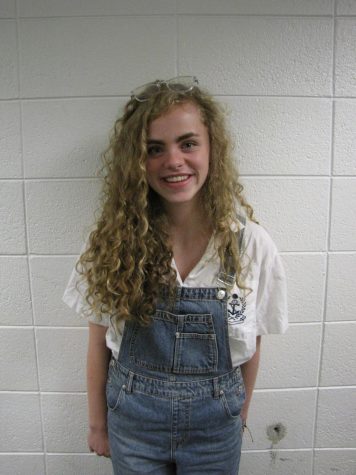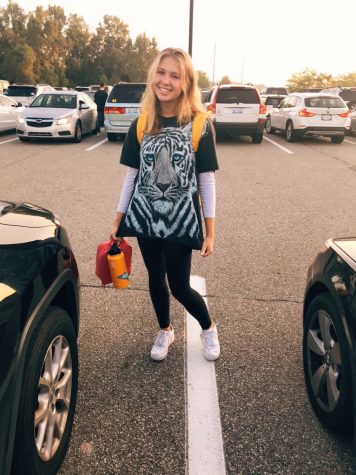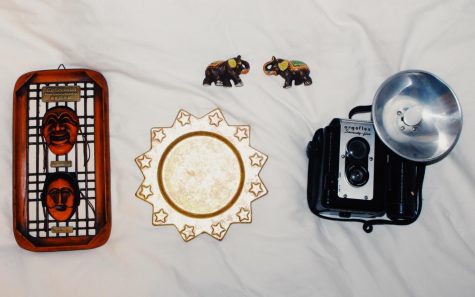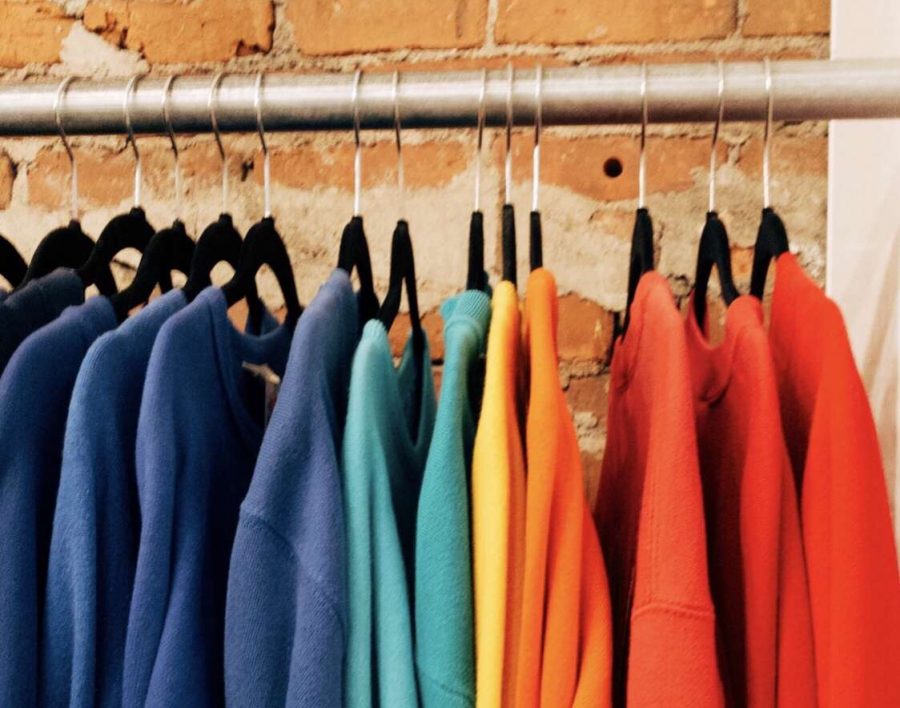Secondhand, not second best: the growth of thrifting among high schoolers

More stories from Linus Kaechele
A clothing rack captured by Mina Siebert on one of her many thrifting expeditions.
Mina’s oversized black tee with the contrasting, ferocious design of a tiger’s face on the front.
Ella’s big, snug, cozy, neutral sweater that her mom “thinks is the ugliest thing ever.”
Aaron’s eccentric, golden candle plate shaped like the sun.
Thrift stores are known to be shops of the unknown; what’s inside is unpredictable. From the most chic, idiosyncratic shirt to the most hideous, old prom dress, the possibilities are endless. The risk and thrill of the unmapped, mysterious nature of thrift stores are what is so appealing to modern-day teenagers and are what’s causing the rise of thrifting in high school fashion trends—FHC included.
Junior Mina Siebert first got the idea to go thrifting after encountering someone on YouTube doing the same thing. A small video discovery led to her unearthing an exciting pastime, and she couldn’t be more pleased that she started.
“It’s fun to thrift,” Mina said. “A lot of the stuff you’ll find you just won’t find in stores because they’re vintage or old or just very unique. It’s just fun to see what you’re going to find.”
This open-mindedness and adventurousness of today’s teens like Mina is what has led to the secondhand shopping industry increasing drastically over the years. According to ThredUp, the largest online consignment and thrift store, Generation Z experienced a forty-six percent growth in the number of Gen Z’ers who have purchased secondhand from 2017 to 2019.
This year, it is estimated that one in three members of Gen Z will own at least one secondhand item.
Senior Ella Guikema is one of those Gen Z’ers who is no stranger to secondhand shopping, but her thrifting experience doesn’t stop at the end of the clothing rack. She checks out every corner of the thrift store, especially the music section.
“I really like picking up records [at thrift stores],” Ella said. “Usually they’re like a dollar. I’ll grab ones that I don’t know—the artist, you know. Then I get to have the adventure of going home and listening to it.”
Ella and Mina both agree that not only do they love the pieces they find from thrift stores, they love the experience and the journey. Mina enjoys thrifting so much that she can go as far as to recall details from the trip to Goodwill the day she found her most prized, thrifted shirt.
“It’s fun to go through racks and be like ‘this is so funny,’” Mina said. “Like [with] my tiger shirt, I was like, ‘this is so funny. Let me go try this on.’ [And now] I wear this every day.”
Mina’s reasoning behind wearing the tiger shirt so often is not only because of the comforting memories it provides her, but also the literal comfort she feels when wearing the shirt.
“If [a shirt is] brand new, it’s all starchy,” Mina said. “I won’t want to wear that, but if I get one from the thrift store, [it’ll] be all comfortable and worn in. I’d much rather buy clothes that people have already worn in [because] they’ve [already] gone through the cycle.”
Mina’s tiger shirt has garnered more compliments than from just herself. One day, one of Mina’s friends asked her if she had gotten her tiger shirt from Urban Outfitters—a costly department store known for their alternative styles. Mina was proud to say that her three-dollar, thrifted shirt was on par with thirty-dollar, department-store shirts.
“It just makes more sense [to thrift] because you [can] find such good quality clothes and such comfortable clothes for [much] cheaper prices,” Mina said. “It’s like going into one store that [is] a million stores combined, and the clothes are fractions of the price. Especially at our age, if you have to pay for your own clothes, no one wants to pay forty dollars for a shirt when I can get 10 items [at] Goodwill for forty dollars.”
Aside from providing more affordable prices, thrifting also offers a more ethical approach to shopping. The reselling of textiles that thrifting is responsible for helps to fight against the growing problem of clothing waste; in 2015, eighty-five percent of textiles were thrown out instead of donated. The increasing popularity of thrifting has led to the dwindling of this percentage because today, forty percent of consumers think about the possible resale value of an item before making a purchase.
Mina makes up a part of that forty percent, but the clothing’s geographical past and potential play a role in her purchases too, not just the monetary potential. Mina’s affinity for thrifting is intertwined with her concern for the environment; as someone who cares for the environment, thrifting is not only a means of obtaining novel pieces but a way to give back to the environment as well.
“If I had a plastic water bottle, [I’d rather have that] plastic water bottle filled up again than buy a new one,” Mina said. “It just makes sense that way. I feel better [about] my secondhand clothes because [they] cut down on the environmental impact.”
Senior Aaron Jachim also understands the textile industry’s impact on the environment and how thrifting factors into that as well. In his sophomore year, Aaron’s TED Talk assignment was centered around the advantages of thrifting—especially the environmental ones. His environmentally conscious attitude is reflected in the contents of his closet.
“I think that it’s really cool that we can make sustainability popular,” Aaron said. “[When shopping in department stores], you pay the price of where [department store clothing] was made and the other payments that you’re not actually paying for. With thrifting, you combat that. I think it’s super awesome that people can recycle clothing and that [thrifted] clothing has been worn before. It [has] carried a bunch of different lifetimes and experiences.”
While all three students value the importance of thrifting’s environmental impact, they also have other driving forces behind their thrifting expeditions.
Ella thrifts not only to fill her closet but also her sense of adventure. Aaron thrifts to keep up with the ever-changing fashion world while still finding ways to branch out. Mina thrifts in order to meet her unique style’s needs in an affordable, simply, yet enjoyable manner. They all, however, enjoy thrifting because it allows them to dress the way they want to and give the impression they want. Thrifted items act as a confidence booster.
“[By] choosing what clothes you put on, you’re basically [saying] ‘okay, this is me,’” Aaron said.
Mina’s comfortable, quality, and cute closet.
Ella’s dark, denim, down-to-earthy designs.
Aaron’s evergreen, especial, evolving ensembles.
Each high schooler has their own sense of style and these three are no exception; thrifting caters to the needs of everyone’s fashion sense. More and more high- schoolers’ fashion senses have started to incorporate secondhand pieces just to feel good about how they look.
Ella puts it best: “look good, feel good, do good.”

Linus Kaechele is a senior entering his final year on staff for The Central Trend, and though he is apprehensive of the current situation, he plans to...



























































































